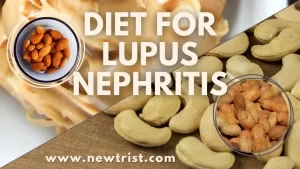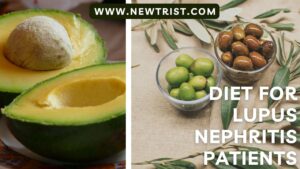Diet for lupus nephritis includes apple, peanut butter, almond butter, cashew butter, oatmeal, yogurt, chia seeds, pineapple, watermelon, cucumbers, eggplant, and onion.
Flaxseed diet for lupus nephritis:
Flaxseed has preventive properties against lupus nephritis. For instance, it can prevent glomerular filtration rate, a crucial sign of renal function, and delay the leakage of protein into the urine (proteinuria).
Flaxseeds can be included in granola, cereal, yogurt, baked products, and smoothies. Flaxseeds can be ground to a coarse or fine powder to get the most nutrition out of them because their fiber content might make them hard to digest.
Best Nutritionist in Bangalore
Consult 19-year-experienced Chief Nutritionist Vasanthi, in person at HSR, Koramangala, Bellandur, Haralur, Electronic city, or online across India.

Table of Contents
Healthy fat diet for lupus nephritis:
The variety of things may seem to be constrained if the kidney function is impaired. To maintain a healthy weight and increase your calorie intake, adding heart-healthy unsaturated fats to your meals and snacks would be a smart option.
Omega-3 fatty acid diet for lupus nephritis:
Omega-3 fatty acids, which are anti-inflammatory and support good immune function, are particularly helpful for autoimmune illnesses. Omega 3 fatty acids can be obtained from both animal and plant sources, including fatty fish like salmon and nuts and seeds.
Healthy diet for lupus nephritis:
As lupus nephritis is an autoimmune disease, there is no specific diet that may completely prevent or treat it. But with any illness, a healthy diet is usually advised, and lupus nephritis is no exception.
A healthy, well-balanced diet and positive lifestyle modifications can help treat any illness and give the body the nutrition it requires. It is advised to have a diet that is well-balanced so that the body can acquire the nutrients it needs for restoration.
Increasing the consumption of good fats
Good fat diet for lupus nephritis
- Apple slices with peanut butter, almond butter, or cashew butter
- Tuna salad or cold cuts can be replaced with fresh salmon fillets.
- Oatmeal or yogurt with chia seeds
- Sandwiches or crackers with guacamole
- Salads with nuts
- For salad dressing, use vinegar and olive oil.
- Walnuts in baked goods
Low-potassium fruits and vegetables
Vegetables and fruits are necessary for optimum health. Potassium is a nutrient found in a variety of fruits and vegetables that aids in maintaining the proper level of cell fluid. Unfortunately, if the kidneys aren’t working properly, too much potassium might be harmful.
You can protect your kidneys and get vitamins, minerals, antioxidants, and dietary fiber by selecting lower-potassium choices.
Low potassium fruits diet for lupus nephritis:
- Applesauce
- Blueberries
- Cranberries
- Pineapple
- Watermelon
Low potassium vegetables diet for lupus nephritis:
- Cucumbers
- Eggplant
- Endive
- Onion
- Raw cabbage
Sodium
- Skip the pickled stuff. Typically, pickles, olives, and other preserved and canned foods have a lot of sodium.
- Choose plant-based proteins or prepare fresh meats. The amount of salt that is added during processing is often significant in cold cuts, hot dogs, sausage, and jerky.
- Play around with flavors without salt. To add flavor without sodium, use fresh herbs, peppers, lemon juice, garlic, onion, or vinegar.
- Read the food labels. Always check the labels before buying condiments, frozen dinners, or snack items to compare the salt content of various products.
- Beware of canned goods. The salt level in canned foods can be reduced by giving them a water rinse. Look for canned soups or beans that are sodium-free. Some canned veggies can be substituted with fresh vegetables.
- Low Sodium Diet: To prevent fluid retention and to regulate high blood pressure, a low sodium diet should be followed. Foods high in protein must be eaten with caution, especially if the kidneys are beginning to disrupt function.
- Heart-healthy foods should be consumed frequently. Depending upon the severity of the disease, it may also be advised to eat meals low in potassium and phosphorus.
Fiber diet for lupus nephritis
Men should consume around 38 g of the fibers contained in whole grains, fruits, and vegetables each day, while women should consume about 25 g. This is because fibers lower blood pressure and C-reactive protein as well as post-prandial glycemia and lipid levels.
When it comes to fiber consumption, drinking sufficient water is important, and going beyond the recommended fiber intake can result in poor nutritional absorption.
High-potassium fruits and vegetables
Fruits and vegetables high in potassium might be difficult for kidneys to process. Knowing which plant-based foods are the highest in potassium will help people with lupus nephritis balance their intake with other foods.
High potassium fruits diet for lupus nephritis:
- Avocado
- Banana
- Cantaloupe
- Dates
- Nectarines
- Oranges
- Prunes
- Pumpkin
- Tomatoes and tomato juice
High potassium vegetables diet for lupus nephritis:
- Artichokes
- Beets and beet greens
- Brussels sprouts
- Parsnips
- Potatoes
- Spinach
- Sweet potatoes
Lupus Nephritis
Systemic lupus erythematosus, a kind of kidney disease, causes lupus nephritis (SLE or lupus). An autoimmune disease, such as lupus, occurs when the body’s cells and organs are attacked by the immune system. Lupus-related kidney damage can deteriorate over time and result in renal failure.
One will require dialysis or a kidney transplant to remain healthy if the kidneys fail. Lupus nephritis can occur in as many as 60% of lupus patients. The kidneys cannot operate correctly and may leak protein when they are inflamed. Lupus nephritis can cause renal failure if it is not treated.
Lupus nephritis prevents the kidneys from:
- Controlling blood pressure and blood volume.
- Filtering wastes out of your blood.
- Maintaining the right levels of body fluids, including salts, acids, and minerals.
- Regulating hormone levels.
Best Food For Lupus Nephritis
- Choose foods with less sodium and potassium.
- Avoid processed foods.
- Eat small portions of protein-rich foods: Chicken, Fish, Red Meat, Eggs, Dairy, Beans, Nuts, Seeds, and whole grains.
- Choose heart-healthy foods: Lean cuts of meat, Skinless poultry, Fish, Beans, Vegetables, Fruits, Low-fat or fat-free milk, and yogurt.
- Food high in omega- 3 fatty acids: Fatty fish, such as mackerel, salmon, oysters, sardines, shrimp, and trout, Seaweed and algae, Chia, and flax seeds, Nuts, and legumes, such as walnuts, kidney beans, and edamame.
- Foods high in antioxidants- Fruits, Vegetables, Nuts and legumes, Oats and granola, Black and green teas.

Foods To Avoid If You Have Lupus Nephritis
- Food high in cholesterol, trans fat, and saturated fat.
- Meats rich in fat, such as liver, organ meats, and dark meats, as well as red meat.
- Alfalfa sprouts, salty foods, sweetened beverages, candy, snacks, and sweets.
These meals can exacerbate steroid adverse effects:
- Both refined and simple carbs (often processed)
- Over-processed food
- Try to stick to fresh foods since processed food frequently has added sugar and salt.
- If a food or beverage has a food label, it has been processed, so be mindful of what is in it. When foods are processed, this indicates that adjustments have been done to the product where fiber or vitamins were removed.
Avoid alfalfa and garlic:
If one has lupus, one should probably avoid eating things like garlic and alfalfa. L-canavanine is an amino acid found in alfalfa sprouts. Allicin, ajoene, and thio sulfinates found in garlic can enhance the immune system and aggravate lupus symptoms.
Vegan Diet For Lupus Nephritis
|
Meal |
Menu |
|
Morning |
Basil water |
|
Breakfast |
Oatmeal |
|
Mid-morning |
Boiled peanuts |
|
Lunch |
Rice + Vegetable curry + Chapati + Dal sabzi |
|
Evening |
Fruits salad with roasted seeds |
|
Dinner |
Chapati + Paneer gravy |
|
Bedtime |
Turmeric milk |

Diet For Lupus Nephritis Patients
- Eat lots of fruits and vegetables — fill half of the plate with fruits and veggies.
- Choose whole grains — like whole-wheat bread and pasta, oatmeal, and brown rice.
- Include healthy proteins — like skinless poultry, seafood, lean meats, beans, nuts, and eggs.
- Pick foods with healthy fats — like olive oil, avocados, nuts, and fish.
- For heart health, eat foods with Omega-3 fatty acids, including:
- Fatty fish — like salmon, mackerel, and sardines.
- Nuts and seeds — like walnuts and flax seeds.
